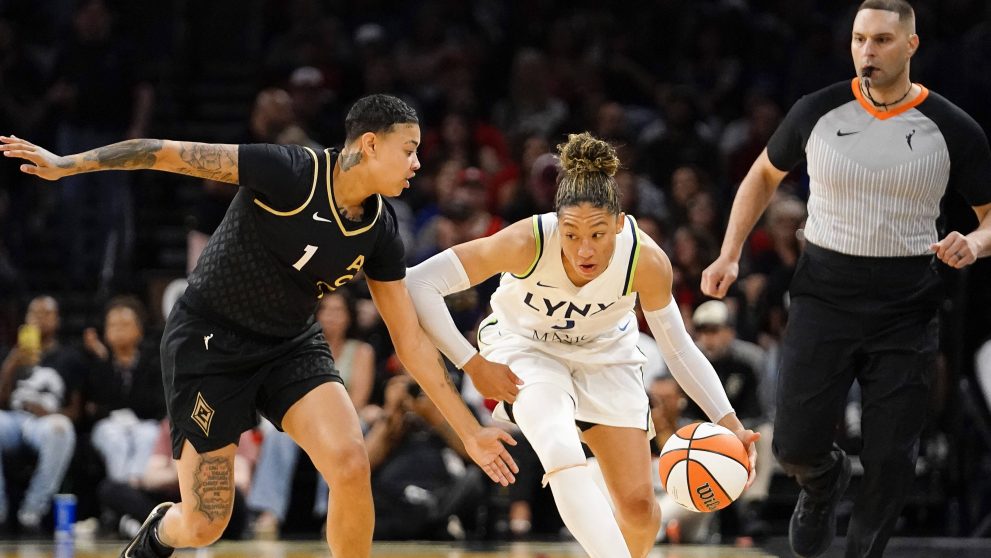The 2023 season has been a bit of a rollercoaster for the Minnesota Lynx, beginning with a 1-7 start, an 8-2 stretch following that, and the inconsistency that comes with being a rebuilding team. The Lynx have been heavily focused on building the bridge to their future as an organization following the retirement of an all-time great in Sylvia Fowles. Inconsistency understandably comes along with the process of rebuilding and rebranding with a youth movement.
The growth of Napheesa Collier into a superstar, and the immediate impact of rookies Diamond Miller and Dorka Juhasz have been bright spots. However, things have not gone smoothly for the entire roster as the Lynx embark on a new era.
Thank you so much. I look forward to them coming to see me play next year with another organization 😊 https://t.co/ofIbzxwVDC
— LIQUID | Aerial Powers (@aerial_powers23) August 20, 2023
After a career stretch after the All-Star break last season, Powers started the year with the Lynx coming off of the bench in a minor bench role (9.8 minutes per game over the first 7 games of the season). Powers then sustained an ankle injury and missed most of the next month before returning to court after the All-Star break.
It’s worth noting that Powers is a protected veteran on a max contract, currently in her final year of a three-year deal. Powers is the only player making $200,000 or more this year who is not a starter in the league (There are 21 players in the W making $200k> but only 19 that qualify this year: Brionna Jones is out for the season and Skylar Diggins-Smith is away from the Mercury), which has become a significant talking point considering that was far from the case last season.
Powers thrived in that late-season push when the Lynx fully leaned into her as a pick-and-roll heavy scorer who could operate out of the middle of the floor, come off of screens, cut, and play a little bit off the ball. 42.2% of her total possessions last season came as a pick-and-roll ballhandler per Synergy Sports.
Over the last 15 games of the season (July onwards), Powers tied for fourth in the league in usage percentage with A’ja Wilson, utilizing 27.8% of Minnesota’s total offensive possessions when she was on the court. Point blank, the Lynx don’t make a near run to the playoffs without the heavy-lifting of Powers in Fowles’ final season.
With Collier back in full, and taking on the highest usage of her career (28.9% compared to 23.3% in 2021), and Miller added into the mix, both building blocks for the future, it would be unfair to assume that Powers would maintain the same role in 2023. Yet, a total drop-off and near removal from the regular rotation has been fairly jarring.
I’m not privy to what in-house off-season conversations were; was there an emphasis on role change? Was an understanding come to on what that might look like (I think we can safely say no)? Was something laid out on how an organic shift could happen within a new environment and context?
Again, understandably, this has sparked the “why wasn’t she traded in the off-season” and “why wasn’t she traded at the deadline” arguments.
The latter is not that simple due to the structure of the Collective Bargaining Agreement, Powers’ contract size, and the nature of the hard cap.
To lay out and define a few things; what is the hard cap and why does it matter? In other leagues, there’s some wiggle room with how much money can be brought back contractually in transactions. That is not currently the case in the W. Moving players on larger contracts is difficult, as it’s not as simple as just aggregating the money needed to match a contract.
Without the ability to take on money over the cap and the nature of having smaller rosters, it’s harder to construct trades that don’t significantly impact or alter a team’s current rotation. With how many teams are still in the mix and competitive, it’s easier said than done to get two teams on the same page both cap-wise and with respect to the actual move even if there’s interest.
The only exception(s) in which a team can surpass the salary cap are the provisions laid out by the CBA: Hardship exceptions and emergency hardship exceptions (Hardship = 1 player out/injured, Emergency Hardship = less than 10 players healthy). There are other stipulations within this, but for our purpose, it’s worth recognizing that the only real way you can operate over the cap is with a hardship exception.
When a team has a hardship exception, their flexibility on the court is improved, but with respect to trades, it severely hinders what a team can do for roster improvement in-season. All teams involved in a trade need to be under the salary cap once the moves are completed, and after the contract guarantee date (July 14th), players can’t be cut to get under the cap.
Essentially, unless a swap is made for nearly identical contracts (especially after the guarantee date and leading into the deadline), it is borderline impossible to construct a deal that both sides will agree to and that can work within the current constraints of the cap.
Here is Aerial Powers on the Trade Deadline from her Twitch: pic.twitter.com/XuMZ0Dx0L2
— Tyler DeLuca (@TylerDeLuca) August 20, 2023
As Powers mentioned live on her Twitch stream, there were teams interested in trading for Powers; she is an established player who can create shots with the ball in her hands and be impactful for a team. However, the aforementioned lack of cap flexibility, along with her contract, makes it very difficult to make a sensible trade.
Aerial Powers is capable of making a positive impact for a team, more than proving herself last season and throughout her career as a whole. She could undoubtedly contribute in the right role on nearly any roster in the league. However, with the size of her contract and what other teams would need to move in order to make a workable and sensible deal for both sides, nothing materialized.
This is a substantial reason for the routine lack of movement around the deadline. It’s not that teams don’t want to make moves, it’s that at present, it is extremely difficult to make moves in a way that makes sense while also fitting inside the salary cap during the season.
Although numbers and cap space can complicate things, there are a multitude of layers to roster construction. Roster flux, a new direction in Minnesota, and different goals have all contributed to the basis of the next era of Lynx basketball.






